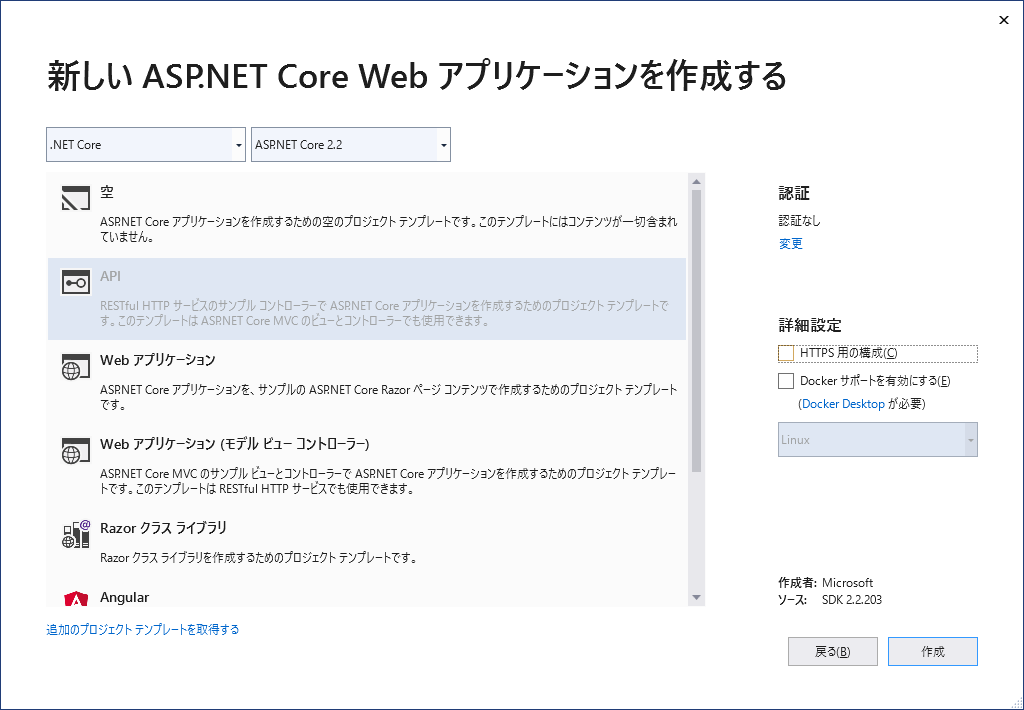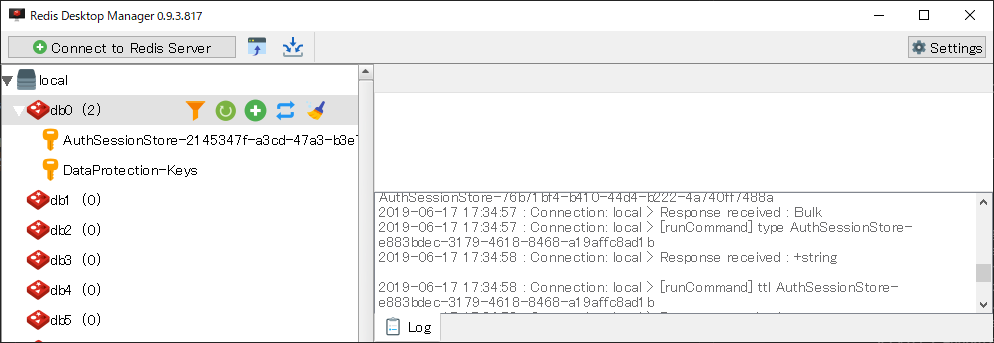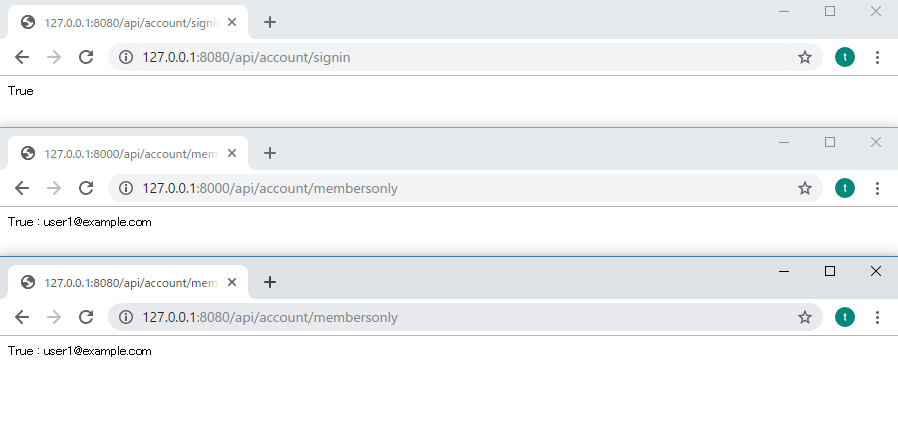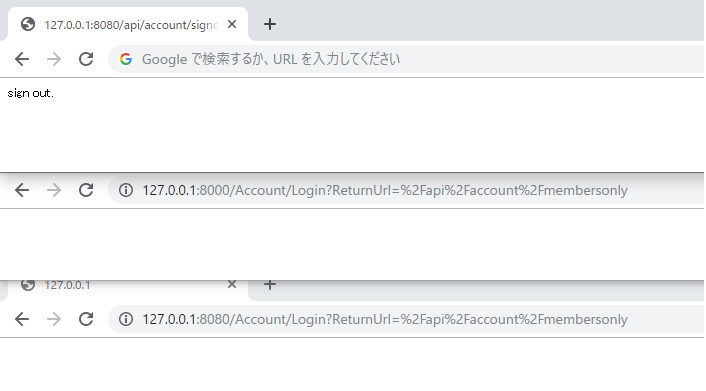ASP.Net Core 2.2 の認証をカスタマイズする必要に迫られたため、必要な作業を整理しました。
ソースコードはこちらです。
カスタマイズする点
下記2点を変更します。
- ユーザー情報の保存先: SQLServer → MySQL
- ログイン情報の保存先: ローカル → Redis
これは次の構成を取るためです。
API(ASP.Net Core) ┬ MySQL
└ Redis
AWSで下記のリソース群を用いることを想定しています。
ALB ー Fargate ┬ Aurora
└ Elasticache
前提条件
- ASP.Net Core 2.2 SDK、Visual Studio 2019、Docker for Windowsが利用できる。
- 接続できるMySQL、Redisがある。
- MySQL for Visual Studio および MySQL Connector/Net がインストール済。
作業手順
プロジェクトの作成
VisualStudio2019から適当な名前をつけてプロジェクトを作成します。ここでは空のAPIを選択しています。
認証用DBの作成
MySQLに接続し、下記SQLを実行します。認証に使うDBとテーブルが用意されます。
CREATE DATABASE `example`;
use `example`;
CREATE TABLE `user` (
`id` int(10) unsigned NOT NULL AUTO_INCREMENT COMMENT 'ID',
`name` varchar(255) COLLATE utf8mb4_bin NOT NULL COMMENT 'ユーザー名(兼メールアドレス)',
`normalized_name` varchar(255) COLLATE utf8mb4_bin NOT NULL COMMENT 'ノーマライズ後ユーザー名',
`security_stamp` varchar(255) COLLATE utf8mb4_bin NOT NULL COMMENT 'セキュリティスタンプ',
`password` varchar(255) COLLATE utf8mb4_bin NOT NULL COMMENT 'パスワード',
PRIMARY KEY (`id`),
UNIQUE KEY `name` (`name`),
UNIQUE KEY `normalized_name` (`normalized_name`)
) ENGINE=InnoDB DEFAULT CHARSET=utf8mb4 COLLATE=utf8mb4_bin COMMENT='ユーザーテーブル';
Entity Frameworkの初期設定
Entity Frameworkを利用するため、次の作業を行います。
- NugetからMySql.Data.EntityFrameworkCoreをインストールします。
- パッケージマネージャーコンソールで下記コマンドを入力します。接続文字列は環境に合わせてご変更下さい。
- Scaffold-DbContext "server=localhost;port=3306;user=root;password=password;database=example" MySql.Data.EntityFrameworkCore -OutputDir Models -f
- EF用のファイルとModelが出力されるため、exampleContext.csのファイル名と中の記載をexampleContext → ExampleContextに修正します。(しなくても動きますが、スネークケースのクラス名が気持ち悪いので)
- appsettings.Development.jsonを修正します。MySQLとRedisの接続文字列は自環境に合わせて下さい。
{
"Logging": {
"LogLevel": {
"Default": "Debug",
"System": "Information",
"Microsoft": "Information"
}
},
"ConnectionStrings": {
"RedisConnection": "127.0.0.1:6379",
"MysqlConnection": "server=127.0.0.1;userid=root;password=password;database=example;"
}
}
- Startup.csを修正します。
//...
using CustomAuthentication.Models;
using Microsoft.EntityFrameworkCore;
//...
public void ConfigureServices(IServiceCollection services)
{
//...
// DB
services.AddDbContext<exampleContext>(options => options.UseMySQL(
Configuration.GetValue<string>("ConnectionStrings:MysqlConnection")
));
}
- テストデータを入れ、かつValuesController.cs を編集するなどして、Entity Frameworkが動作することを確認します。
//...
using Microsoft.EntityFrameworkCore;
//...
namespace CustomAuthentication.Controllers
{
[Route("api/[controller]")]
[ApiController]
public class ValuesController : ControllerBase
{
private readonly ExampleContext _context;
public ValuesController(ExampleContext context)
{
_context = context;
}
// GET api/values
[HttpGet]
public async Task<IEnumerable<User>> Get()
{
return await _context.User.ToListAsync();
}
//...
IUserStoreの実現
認証に必要なのはサインアップ(登録)、サインイン(ログイン)、サインアウト(ログアウト)です。
サインアップにはUserManagerを使います。サインインとサインアウトにはSignInManagerを使います。
SignInManagerはUserManagerに依存しています。UserManagerはIUserStoreに依存しています。
そこでIUserStoreを実現するCustomUserStoreクラスを作成し、FWに登録します。IRoleStoreを実現したクラスもないと動かないためCustomRoleStoreクラスも追加します。これらはそれぞれUserStoreBase、RoleStoreBaseから継承して作成します。
CustomUserStore作成
using System;
using System.Collections.Generic;
using System.Linq;
using System.Security.Claims;
using System.Threading;
using System.Threading.Tasks;
using CustomAuthentication.Models;
using Microsoft.AspNetCore.Identity;
namespace CustomAuthentication
{
class CustomUserStore : UserStoreBase<IdentityUser, string, IdentityUserClaim<string>, IdentityUserLogin<string>, IdentityUserToken<string>>
{
private readonly ExampleContext _context;
private readonly IdentityErrorDescriber _describer;
public CustomUserStore(IdentityErrorDescriber describer, ExampleContext context) : base(describer)
{
_describer = describer;
_context = context;
}
public override async Task<IdentityResult> CreateAsync(IdentityUser user, CancellationToken cancellationToken = new CancellationToken())
{
_context.User.Add(new User() { Name = user.UserName, NormalizedName = user.NormalizedUserName, SecurityStamp = user.SecurityStamp, Password = user.PasswordHash });
await _context.SaveChangesAsync();
return IdentityResult.Success;
}
public override async Task<IdentityResult> UpdateAsync(IdentityUser user, CancellationToken cancellationToken = new CancellationToken())
=> throw new NotImplementedException();
public override async Task<IdentityResult> DeleteAsync(IdentityUser user, CancellationToken cancellationToken = new CancellationToken())
=> throw new NotImplementedException();
public override async Task<IdentityUser> FindByIdAsync(string userId, CancellationToken cancellationToken = new CancellationToken())
=> throw new NotImplementedException();
public override async Task<IdentityUser> FindByNameAsync(string normalizedUserName, CancellationToken cancellationToken = new CancellationToken())
{
var user = _context.User.FirstOrDefault(x => x.NormalizedName == normalizedUserName);
if (user == null)
return null;
return new IdentityUser()
{
Id = user.Id.ToString(),
UserName = user.Name,
PasswordHash = user.Password,
SecurityStamp = user.SecurityStamp,
};
}
protected override async Task<IdentityUser> FindUserAsync(string userId, CancellationToken cancellationToken)
=> throw new NotImplementedException();
protected override async Task<IdentityUserLogin<string>> FindUserLoginAsync(string userId, string loginProvider, string providerKey, CancellationToken cancellationToken)
=> throw new NotImplementedException();
protected override async Task<IdentityUserLogin<string>> FindUserLoginAsync(string loginProvider, string providerKey, CancellationToken cancellationToken)
=> throw new NotImplementedException();
public override async Task<IList<Claim>> GetClaimsAsync(IdentityUser user, CancellationToken cancellationToken = new CancellationToken())
=> new Claim[0];
public override async Task AddClaimsAsync(IdentityUser user, IEnumerable<Claim> claims, CancellationToken cancellationToken = new CancellationToken())
=> throw new NotImplementedException();
public override async Task ReplaceClaimAsync(IdentityUser user, Claim claim, Claim newClaim, CancellationToken cancellationToken = new CancellationToken())
=> throw new NotImplementedException();
public override async Task RemoveClaimsAsync(IdentityUser user, IEnumerable<Claim> claims, CancellationToken cancellationToken = new CancellationToken())
=> throw new NotImplementedException();
public override async Task<IList<IdentityUser>> GetUsersForClaimAsync(Claim claim, CancellationToken cancellationToken = new CancellationToken())
=> throw new NotImplementedException();
protected override async Task<IdentityUserToken<string>> FindTokenAsync(IdentityUser user, string loginProvider, string name, CancellationToken cancellationToken)
=> throw new NotImplementedException();
protected override async Task AddUserTokenAsync(IdentityUserToken<string> token)
=> throw new NotImplementedException();
protected override async Task RemoveUserTokenAsync(IdentityUserToken<string> token)
=> throw new NotImplementedException();
public override IQueryable<IdentityUser> Users
=> throw new NotImplementedException();
public override async Task AddLoginAsync(IdentityUser user, UserLoginInfo login, CancellationToken cancellationToken = new CancellationToken())
=> throw new NotImplementedException();
public override async Task RemoveLoginAsync(IdentityUser user, string loginProvider, string providerKey, CancellationToken cancellationToken = new CancellationToken())
=> throw new NotImplementedException();
public override async Task<IList<UserLoginInfo>> GetLoginsAsync(IdentityUser user, CancellationToken cancellationToken = new CancellationToken())
=> throw new NotImplementedException();
public override async Task<IdentityUser> FindByEmailAsync(string normalizedEmail, CancellationToken cancellationToken = new CancellationToken())
=> throw new NotImplementedException();
}
}
CustomRoleStore作成
using System;
using System.Collections.Generic;
using System.Linq;
using System.Security.Claims;
using System.Threading;
using System.Threading.Tasks;
using Microsoft.AspNetCore.Identity;
namespace CustomAuthentication
{
class CustomRoleStore : RoleStoreBase<IdentityRole, string, IdentityUserRole<string>, IdentityRoleClaim<string>>
{
private readonly IdentityErrorDescriber _describer;
public CustomRoleStore(IdentityErrorDescriber describer) : base(describer)
{
_describer = describer;
}
public override async Task<IdentityResult> CreateAsync(IdentityRole role, CancellationToken cancellationToken = new CancellationToken())
=> throw new NotImplementedException();
public override async Task<IdentityResult> UpdateAsync(IdentityRole role, CancellationToken cancellationToken = new CancellationToken())
=> throw new NotImplementedException();
public override async Task<IdentityResult> DeleteAsync(IdentityRole role, CancellationToken cancellationToken = new CancellationToken())
=> throw new NotImplementedException();
public override async Task<IdentityRole> FindByIdAsync(string id, CancellationToken cancellationToken = new CancellationToken())
=> throw new NotImplementedException();
public override async Task<IdentityRole> FindByNameAsync(string normalizedName, CancellationToken cancellationToken = new CancellationToken())
=> throw new NotImplementedException();
public override async Task<IList<Claim>> GetClaimsAsync(IdentityRole role, CancellationToken cancellationToken = new CancellationToken())
=> throw new NotImplementedException();
public override async Task AddClaimAsync(IdentityRole role, Claim claim, CancellationToken cancellationToken = new CancellationToken())
=> throw new NotImplementedException();
public override async Task RemoveClaimAsync(IdentityRole role, Claim claim, CancellationToken cancellationToken = new CancellationToken())
=> throw new NotImplementedException();
public override IQueryable<IdentityRole> Roles
=> throw new NotImplementedException();
}
}
Startup.csに登録
//...
using Microsoft.AspNetCore.Identity;
//...
public void ConfigureServices(IServiceCollection services)
{
//...
// Identity
services.AddIdentity<IdentityUser, IdentityRole>(options =>
{
options.Password.RequireDigit = false;
options.Password.RequireLowercase = false;
options.Password.RequireNonAlphanumeric = false;
options.Password.RequireUppercase = false;
options.Password.RequiredLength = 6;
})
.AddUserStore<CustomUserStore>()
.AddRoleStore<CustomRoleStore>()
.AddDefaultTokenProviders();
}
public void Configure(IApplicationBuilder app, IHostingEnvironment env)
{
//...
app.UseAuthentication();
//...
}
}
}
AccountController
ここまででサインアップ・サインイン・サインアウトができるはずです。
Controllerから実際に動かしてみます。
using System.Threading.Tasks;
using Microsoft.AspNetCore.Authorization;
using Microsoft.AspNetCore.Identity;
using Microsoft.AspNetCore.Mvc;
namespace ApiIdentity.Controllers
{
[Route("api/[controller]")]
[ApiController]
public class AccountController : ControllerBase
{
private readonly SignInManager<IdentityUser> _signInManager;
private readonly UserManager<IdentityUser> _userManager;
// ※ 実際はユーザーの入力を受け取ります
private readonly string email = "user1@example.com";
private readonly string password = "123456aA!";
public AccountController(SignInManager<IdentityUser> signInManager, UserManager<IdentityUser> userManager)
{
_signInManager = signInManager;
_userManager = userManager;
}
[HttpGet("signup")]
[AllowAnonymous]
public async Task<string> SignUp()
{
var createResult = await _userManager.CreateAsync(new IdentityUser(){ UserName = email }, password);
return createResult.Succeeded.ToString();
}
[HttpGet("signin")]
[AllowAnonymous]
public async Task<string> SignIn()
{
var signInResult = await _signInManager.PasswordSignInAsync(email, password, false, false);
return signInResult.Succeeded.ToString();
}
[HttpGet("signout")]
[AllowAnonymous]
public async Task<string> SignOut()
{
await _signInManager.SignOutAsync();
return "sign out.";
}
[HttpGet("membersonly")]
[Authorize]
public string MembersOnly()
{
var isSignedIn = _signInManager.IsSignedIn(this.User);
var userName = _userManager.GetUserName(this.User);
return isSignedIn.ToString() + " : " + userName;
}
//...
}
}
//...
ログイン情報の保存先をRedisに変更する
ASP.NetCoreのデフォルトでは、ログイン情報を各ノードがローカルに保存するようです。しかし、アプリケーションサーバーをスケールインした時にログイン情報が揮発するのは困ります。そこで共用のRedisに保存できるよう、ITicketStoreを実現したクラスをSessionStoreとして登録します。
参考: Storing ASP.NET core identity authorization tickets in Redis.
これにはData Protectionも設定しないと正しく動作しなかったため、同時にこちらも設定します。
参考: ASP.NET Coreのセッション情報をRedisに格納する方法
- NugetからMicrosoft.Extensions.Caching.StackExchangeRedis とMicrosoft.AspNetCore.DataProtection.StackExchangeRedisをインストールします。
- ITicketStoreを実現するクラスを作成します。
using System;
using System.Threading.Tasks;
using Microsoft.AspNetCore.Authentication;
using Microsoft.AspNetCore.Authentication.Cookies;
using StackExchange.Redis;
namespace CustomAuthentication
{
public class RedisTicketStore : ITicketStore
{
private readonly string KeyPrefix = "AuthSessionStore-";
private IDatabase _cache;
public RedisTicketStore(IConnectionMultiplexer redis)
{
_cache = redis.GetDatabase();
}
public async Task<string> StoreAsync(AuthenticationTicket ticket)
{
var key = KeyPrefix + Guid.NewGuid().ToString();
await RenewAsync(key, ticket);
return key;
}
public async Task RenewAsync(string key, AuthenticationTicket ticket)
{
byte[] val = TicketSerializer.Default.Serialize(ticket);
await _cache.StringSetAsync(key, val);
}
public async Task<AuthenticationTicket> RetrieveAsync(string key)
{
var bytes = await _cache.StringGetAsync(key);
var ticket = TicketSerializer.Default.Deserialize(bytes);
return ticket;
}
public async Task RemoveAsync(string key)
=> await _cache.KeyDeleteAsync(key);
}
}
- StartUp.csを修正します。
//...
using Microsoft.AspNetCore.DataProtection;
using StackExchange.Redis;
//...
public void ConfigureServices(IServiceCollection services)
{
//...
// Redis
services.AddSingleton<IConnectionMultiplexer>(ConnectionMultiplexer.Connect(Configuration.GetValue<string>("ConnectionStrings:RedisConnection")));
services.AddScoped<RedisTicketStore>();
services.ConfigureApplicationCookie(options => options.SessionStore = services.BuildServiceProvider().GetRequiredService<RedisTicketStore>());
services.AddDataProtection()
.SetApplicationName("CustomAuthentication")
.PersistKeysToStackExchangeRedis(services.BuildServiceProvider().GetRequiredService<IConnectionMultiplexer>(), "DataProtection-Keys");
//...
}
}
}
実行するとRedisにDataProtectionとログインの情報が保存されます。
動作確認
異なるアプリサーバ間で本当にログイン情報を共有できているか、コンテナを使ってテストしてみます。
次の作業を行います。
- appsettings.UnitTest.jsonを追加します。
{
"Logging": {
"LogLevel": {
"Default": "Debug",
"System": "Information",
"Microsoft": "Information"
}
},
"ConnectionStrings": {
"RedisConnection": "redis:6379",
"MysqlConnection": "server=mysql;userid=root;password=password;database=example;"
}
}
- powershellを起動し、CustomAuthentication.slnのあるディレクトリで下記コマンドを実行します。VisualStudioとローカルでポートを占有しているサービスは事前に落としておく必要があります。
dotnet publish -c Release -o out
docker-compose build --no-cache
docker-compose up
- 利用する設定ファイルは下記となります。
- docker-compose.yml
version: '3'
services:
webapp1:
build:
context: .
dockerfile: app.dockerfile
ports:
- "8000:8000"
depends_on:
- redis
- mysql
environment:
- ASPNETCORE_ENVIRONMENT=UnitTest
- ASPNETCORE_URLS=http://+:8000
webapp2:
build:
context: .
dockerfile: app.dockerfile
ports:
- "8080:8080"
depends_on:
- redis
- mysql
environment:
- ASPNETCORE_ENVIRONMENT=UnitTest
- ASPNETCORE_URLS=http://+:8080
redis:
build:
context: .
dockerfile: redis.dockerfile
container_name: redis
ports:
- "6379:6379"
mysql:
build:
context: .
dockerfile: mysql.dockerfile
command: mysqld --character-set-server=utf8mb4 --collation-server=utf8mb4_bin
container_name: mysql
ports:
- "3306:3306"
environment:
- MYSQL_ROOT_PASSWORD=password
- app.dockerfile
FROM mcr.microsoft.com/dotnet/core/aspnet:2.2
COPY ./CustomAuthentication/out/ /app/
WORKDIR /app/
ENTRYPOINT ["dotnet", "CustomAuthentication.dll"]
- redis.dockerfile
FROM redis:5.0
- mysql.dockerfile
FROM mysql:5.7
COPY ./init.sql /docker-entrypoint-initdb.d/
- init.sql
DROP DATABASE IF EXISTS `example`;
CREATE DATABASE `example`;
use `example`;
CREATE TABLE `user` (
`id` int(10) unsigned NOT NULL AUTO_INCREMENT COMMENT 'ID',
`name` varchar(255) COLLATE utf8mb4_bin NOT NULL COMMENT 'ユーザー名(兼メールアドレス)',
`normalized_name` varchar(255) COLLATE utf8mb4_bin NOT NULL COMMENT 'ノーマライズ後ユーザー名',
`security_stamp` varchar(255) COLLATE utf8mb4_bin NOT NULL COMMENT 'セキュリティスタンプ',
`password` varchar(255) COLLATE utf8mb4_bin NOT NULL COMMENT 'パスワード',
PRIMARY KEY (`id`),
UNIQUE KEY `name` (`name`),
UNIQUE KEY `normalized_name` (`normalized_name`)
) ENGINE=InnoDB DEFAULT CHARSET=utf8mb4 COLLATE=utf8mb4_bin COMMENT='ユーザーテーブル';
CREATE TABLE `role` (
`id` int(10) unsigned NOT NULL COMMENT 'ID',
`user_id` int(10) unsigned NOT NULL COMMENT 'ID',
`role` varchar(20) COLLATE utf8mb4_bin NOT NULL COMMENT 'ロール名',
PRIMARY KEY (`id`),
UNIQUE KEY `user_id` (`user_id`)
) ENGINE=InnoDB DEFAULT CHARSET=utf8mb4 COLLATE=utf8mb4_bin COMMENT='ロール';
- http://127.0.0.1:8000/api/account/signup にアクセスし、次に http://127.0.0.1:8080/api/account/signin にアクセスした後、http://127.0.0.1:8000/api/account/membersonly と http://127.0.0.1:8080/api/account/membersonly の両方を閲覧できることを確認します。
- Redisに入っているログイン情報が一つだけであることを確認します。
- http://127.0.0.1:8080/api/account/signout にアクセスし、http://127.0.0.1:8000/api/account/membersonly と http://127.0.0.1:8080/api/account/membersonly の両方が閲覧できないことを確認します。
以上。





